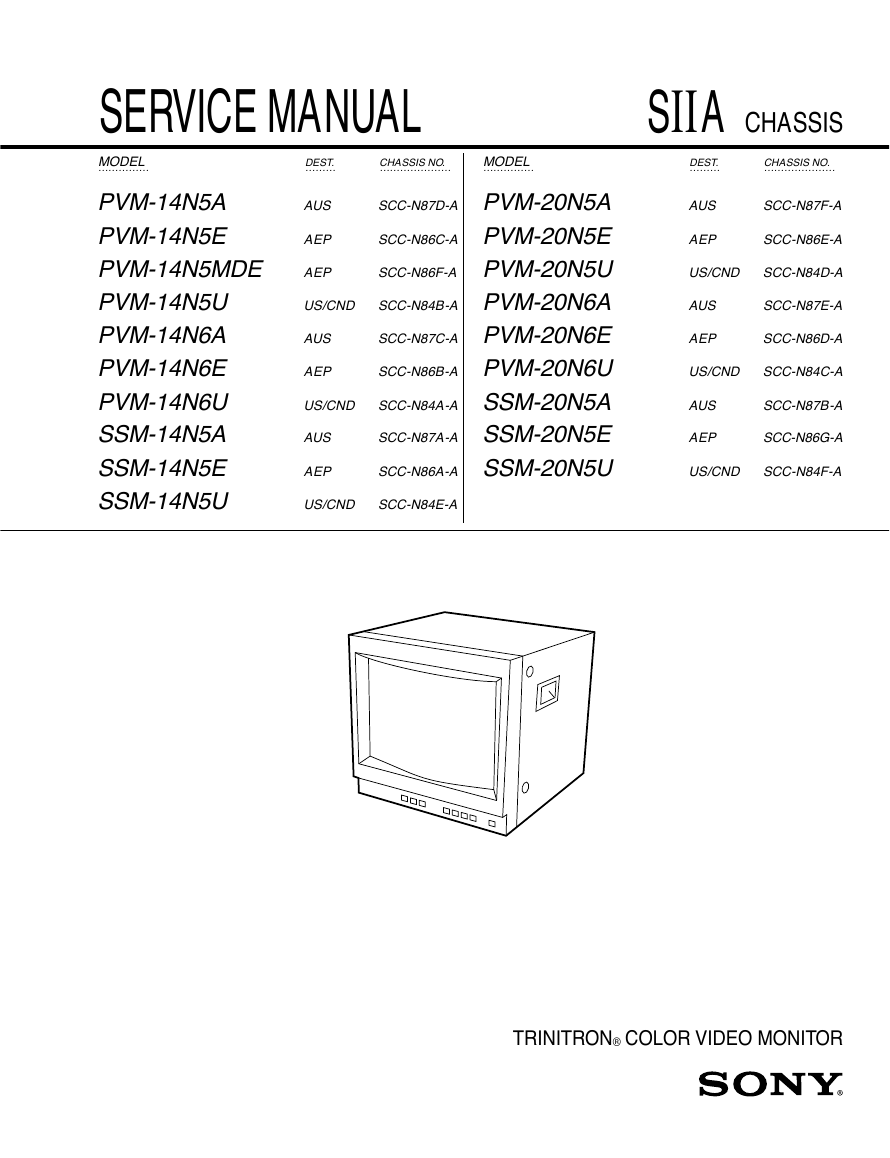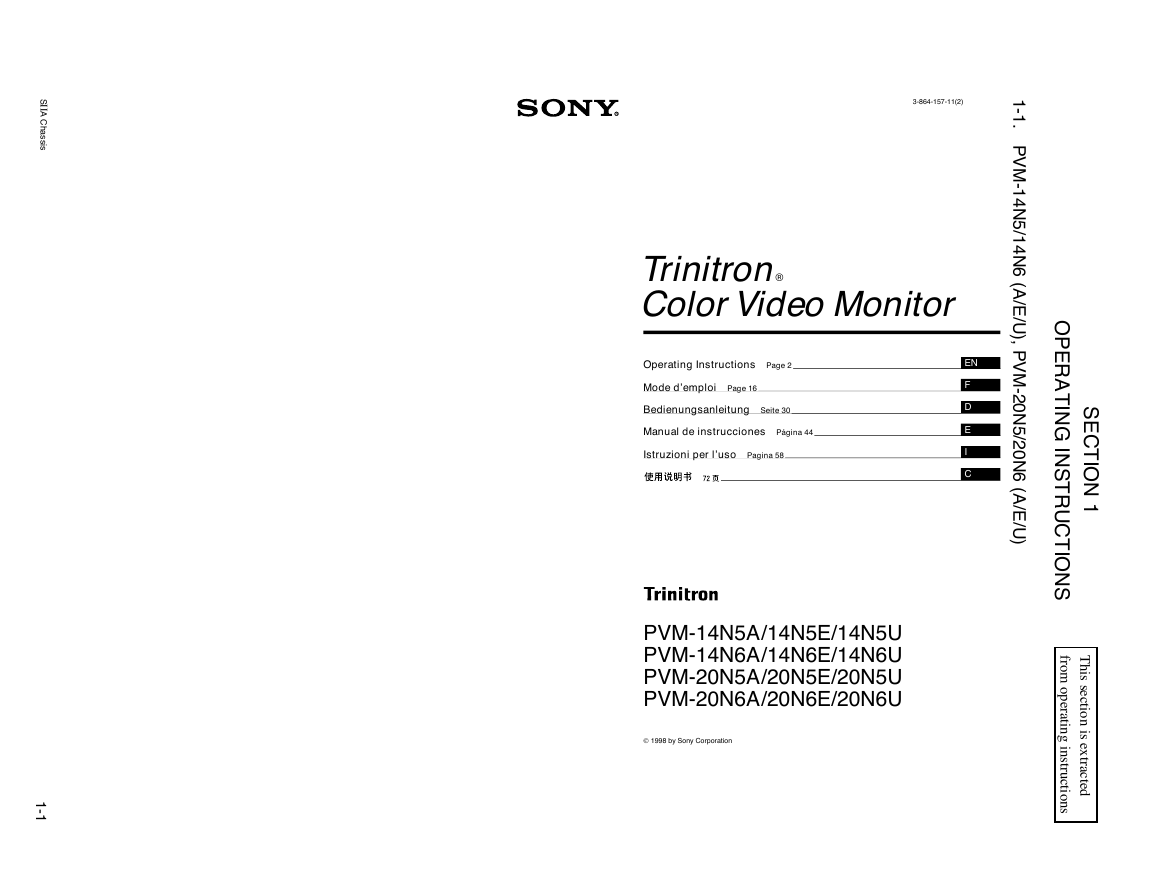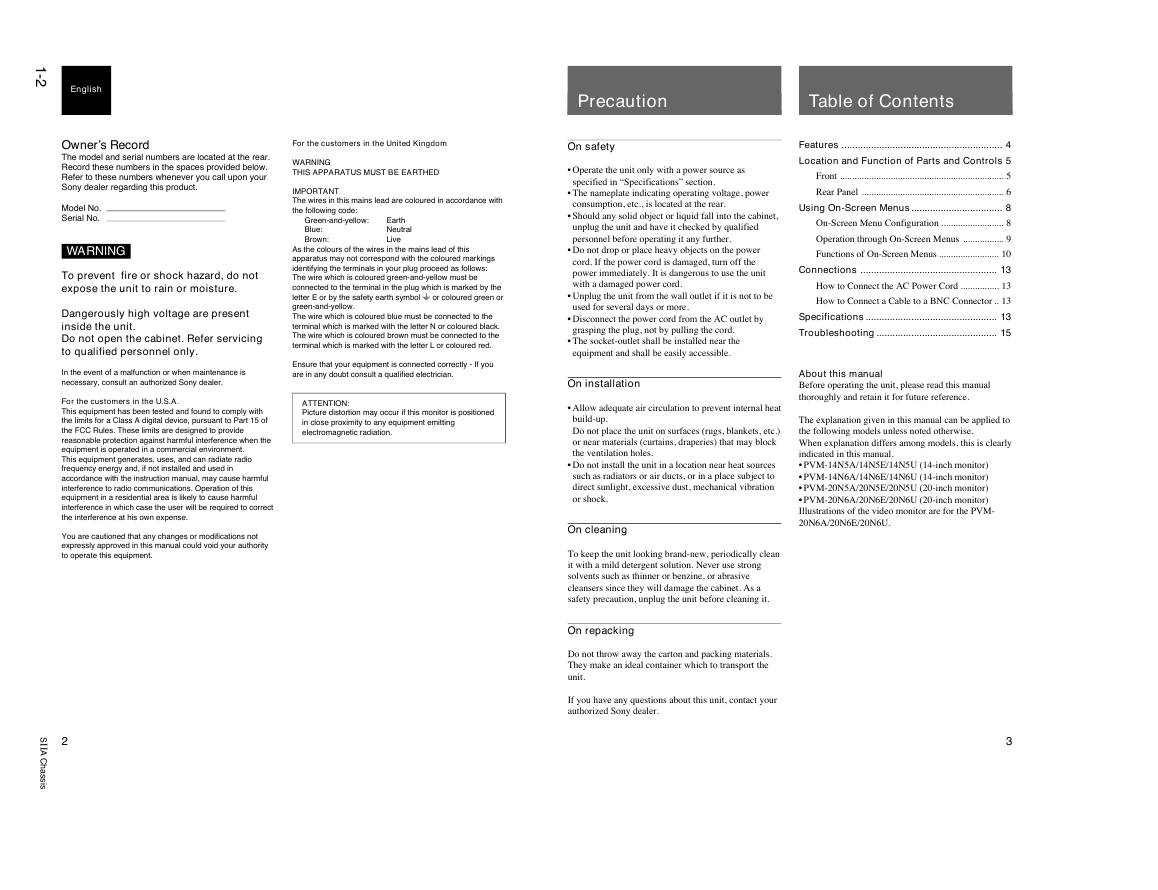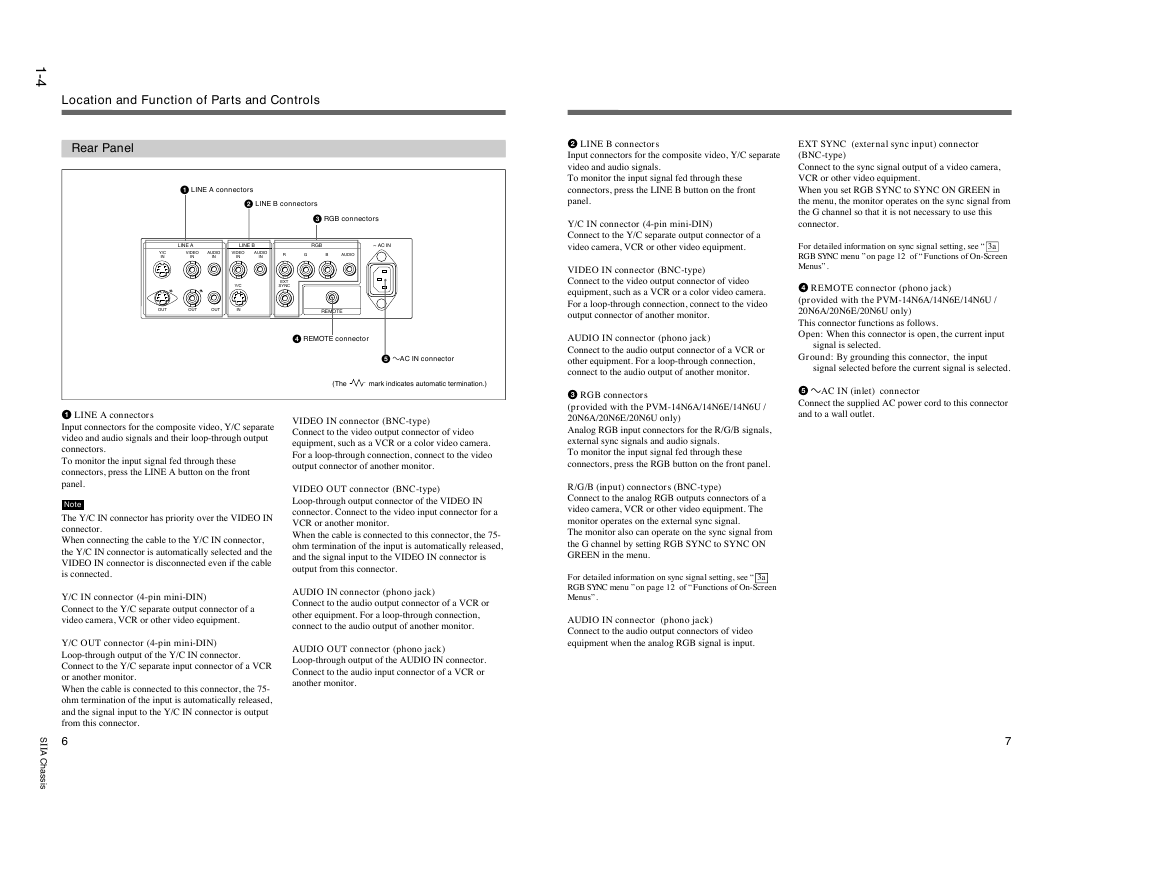SERVICE MANUAL
SIIA
CHASSIS
MODEL
……………
DEST.
………
CHASSIS NO.
…………………
MODEL
……………
DEST.
………
CHASSIS NO.
…………………
SCC-N87D-A
SCC-N86C-A
SCC-N86F-A
SCC-N87C-A
SCC-N86B-A
US/CND SCC-N84B-A
AUS
PVM-14N5A
PVM-14N5E
AEP
PVM-14N5MDE AEP
PVM-14N5U
PVM-14N6A
PVM-14N6E
PVM-14N6U
SSM-14N5A
SSM-14N5E
SSM-14N5U
AEP
AUS
US/CND SCC-N84A-A
AUS
AEP
SCC-N87A-A
SCC-N86A-A
US/CND SCC-N84E-A
PVM-20N5A
PVM-20N5E
PVM-20N5U
PVM-20N6A
PVM-20N6E
PVM-20N6U
SSM-20N5A
SSM-20N5E
SSM-20N5U
AUS
AEP
SCC-N87F-A
SCC-N86E-A
US/CND SCC-N84D-A
AUS
AEP
SCC-N87E-A
SCC-N86D-A
US/CND SCC-N84C-A
AUS
AEP
SCC-N87B-A
SCC-N86G-A
US/CND SCC-N84F-A
TRINITRON® COLOR VIDEO MONITOR
�
! WARNING
This manual is intended for qualified service personnel
only.
To reduce the risk of electric shock, fire or injury, do not
perform any servicing other than that contained in the
operating instructions unless you are qualified to do so.
Refer all servicing to qualified service personnel.
(PVM-14N5MDE only)
Electromagnetic
Compatibility
This device compiles with the requirements of Directive 89/336/EEC
concerning electromagnetic compatibility.
This device meets EN50081-1/92 and EN50082-1/92.
WARNING!!
ATTENTION!!
AN ISOLATION TRANSFORMER SHOULD BE USED DURING ANY
SERVICE TO AVOID POSSIBLE SHOCK HAZARD, BECAUSE OF
LIVE CHASSIS.
THE CHASSIS OF THIS RECEIVER IS DIRECTLY CONNECTED TO
THE AC POWER LINE.
AFIN D’EVITER TOUT RISQUE D’ELECTROCUTION PROVENANT
D’UN CHÁSSIS SOUS TENSION, UN TRANSFORMATEUR
D’ISOLEMENT DOIT ETRE UTILISÉ LORS DE TOUT DÉPANNAGE.
LE CHÁSSIS DE CE RÉCEPTEUR EST DIRECTEMENT
RACCORDÉ À L’ALIMENTATION SECTEUR.
SAFETY-RELATED COMPONENT WARNING!!
COMPONENTS IDENTIFIED BY MARK !!!!! ON THE SCHEMATIC
DIAGRAMS, EXPLODED VIEWS AND
IN THE PARTS
LIST ARE CRITICAL TO SAFE OPERATION. REPLACE THESE
COMPONENTS WITH SONY PARTS WHOSE PART NUMBERS
APPEAR AS SHOWN IN THIS MANUAL OR IN SUPPLEMENTS
PUBLISHED BY SONY. CIRCUIT ADJUSTMENTS THAT ARE
CRITICAL TO SAFE OPERATION ARE IDENTIFIED IN THIS
MANUAL. FOLLOW THESE PROCEDURES WHENEVER CRITICAL
COMPONENTS ARE REPLACED OR IMPROPER OPERATION IS
SUSPECTED.
ATTENTION AUX COMPOSANTS RELATIFS À LA
SÉCURITÉ!!
LES COMPOSANTS IDENTIFIÈS PAR UNE TRAME ET PAR UNE
MARPUE !!!!! SUR LES SCHÉMAS DE PRINCIPE, LES VUES
EXPLOSÉES ET LES LISTES DE PIECES CONT D’UNE
IMPORTANCE CRITIQUE PUR LA SÉCURITÉ DU
FONCTIONNEMENT. NE LES REMPLACER QUE PAR DES
COMPOSANTS SONY DONT LE NUMÉRO DE PIÉCE EST INDIQUÉ
DANS LE PRÉSENT MANUEL OU DANS DES SUPPLÉMENTS
PUBLIÉS PAR SONY. LES RÉGLAGES DE CIRCUIT DONT
L’IMPORTANCE EST CRITIQUE POUR LA SÉCURITÉ DU
FONCTIONNEMENT SONT IDENTIFIES DANS LE PRÉSENT
MANUEL. SUIVRE CES PROCÉDURES LORS DE CHAQUE
REMPLACEMENT DE COMPOSANTS CRITIQUES, OU
LORSQU’UN MAUVAIS FONCTIONNEMENT EST SUSPECTÉ.
�
TABLE OF CONTENTS
1. OPERATING INSTRUCTIONS
1-1. PVM-14N5/14N6 (A/E/U), PVM-20N5/20N6 (A/E/U) ................................ 1-1
1-2. PVM-14N5MDE ............................................................................................ 1-9
1-3. SSM-14N5 (A/E/U), SSM-20N5 (A/E/U) ................................................... 1-18
2. SERVICE INFORMATION
2-1. CIRCUIT BOARDS LOCATION ................................................................. 2-1
2-2. DISASSEMBLY ............................................................................................ 2-2
2-2-1. Cabinet Removal .................................................................................... 2-2
2-2-2. A Board Removal ................................................................................... 2-2
2-2-3. Service Position ...................................................................................... 2-2
2-2-4. Picture Tube Removal ............................................................................ 2-3
2-2-5. Removal of Anode-cap ........................................................................... 2-4
3. SET-UP ADJUSTMENTS
3-1. PREPARATIONS (1) ..................................................................................... 3-1
3-2. PREPARATIONS (2) ..................................................................................... 3-4
3-3. OUTPUTTING IMAGES .............................................................................. 3-4
3-4. RASTER CENTERING ADJUSTMENT ...................................................... 3-4
3-5. LANDING ADJUSTMENT ........................................................................... 3-5
3-6. CONVERGENCE ADJUSTMENT ............................................................... 3-6
3-7. INCLINATION OF DEFLECTION YOKE ADJUSTMENT ....................... 3-7
3-8. G2 ADJUSTMENT ........................................................................................ 3-8
3-9. WHITE BALANCE ADJUSTMENTS .......................................................... 3-8
3-9-1. VIDEO (Except SECAM) Adjustment .................................................. 3-8
3-9-2. Analog RGB Adjustment (PVM-14N6A, PVM-14N6E, PVM-14N6U,
PVM-20N6E, PVM-20N6U) .................................................................. 3-9
3-9-3. SECAM Cut-off Adjustment ................................................................ 3-10
3-9-4. Sub-Brightness Adjustment .................................................................. 3-10
3-10. FOCUS ADJUSTMENT .............................................................................. 3-10
4. SAFETY RELATED ADJUSTMENTS
4-1. B+ VOLTAGE CHECK ................................................................................ 4-1
4-2. PROTECTION CIRCUIT (HOLD-DOWN CIRCUIT) CHECK .................. 4-2
5. CIRCUIT ADJUSTMENTS
5-1. PREPARATIONS .......................................................................................... 5-1
5-2. DEFLECTION SYSTEM ADJUSTMENT ................................................... 5-1
5-2-1. Vertical Deflection Section Adjustment ................................................. 5-1
5-2-2. Horizontal Deflection Section Adjustment ............................................ 5-1
5-2-3. Horizontal Centering Adjustment ........................................................... 5-2
SIIA Chassis
1
�
6. SEMICONDUCTORS
7. EXPLODED VIEWS
7-1. CHASSIS (14-INCH) ..................................................................................... 7-2
7-2. CHASSIS (20-INCH) ..................................................................................... 7-3
8. ELECTRICAL PARTS LIST
9. BLOCK DIAGRAMS
10. DIAGRAMS
10-1. FRAME SCHEMATIC DIAGRAMS .......................................................... 10-1
10-2. SCHEMATIC DIAGRAMS/PRINTED WIRING BOARDS ..................... 10-1
SCHEMATIC DIAGRAMS
A (1/2) Board ..................................................................................................... 10-4
A (2/2) Board ..................................................................................................... 10-6
CA Board ........................................................................................................... 10-8
CB Board ............................................................................................................ 10-9
Q Board ............................................................................................................ 10-11
PRINTED WIRING BOARDS
A Board .............................................................................................................. 10-2
CA Board ........................................................................................................... 10-8
CB Board ............................................................................................................ 10-9
Q Board ............................................................................................................ 10-10
2
SIIA Chassis
�
S
I
I
A
C
h
a
s
s
s
i
3-864-157-11(2)
Trinitron ®
Color Video Monitor
1
-
1
.
P
V
M
-
1
4
N
5
1
4
N
6
(
/
/
A
E
U
/
Operating Instructions Page 2
Mode d’emploi Page 16
Bedienungsanleitung Seite 30
Manual de instrucciones Página 44
Istruzioni per l’uso Pagina 58
###### 72
EN
F
D
E
I
C
)
,
P
V
M
-
2
0
N
5
/
2
0
N
6
(
/
A
E
U
/
)
PVM-14N5A/14N5E/14N5U
PVM-14N6A/14N6E/14N6U
PVM-20N5A/20N5E/20N5U
PVM-20N6A/20N6E/20N6U
1998 by Sony Corporation
1
-
1
O
P
E
R
A
T
N
G
I
I
N
S
T
R
U
C
T
O
N
S
I
S
E
C
T
O
N
1
I
T
h
i
s
s
e
c
t
i
o
n
i
s
e
x
t
r
a
c
t
e
d
f
r
o
m
o
p
e
r
a
t
i
n
g
i
n
s
t
r
u
c
t
i
o
n
s
ª
�
1
-
2
English
Owner’s Record
The model and serial numbers are located at the rear.
Record these numbers in the spaces provided below.
Refer to these numbers whenever you call upon your
Sony dealer regarding this product.
Model No.
Serial No.
WARNING
To prevent fire or shock hazard, do not
expose the unit to rain or moisture.
Dangerously high voltage are present
inside the unit.
Do not open the cabinet. Refer servicing
to qualified personnel only.
In the event of a malfunction or when maintenance is
necessary, consult an authorized Sony dealer.
For the customers in the U.S.A.
This equipment has been tested and found to comply with
the limits for a Class A digital device, pursuant to Part 15 of
the FCC Rules. These limits are designed to provide
reasonable protection against harmful interference when the
equipment is operated in a commercial environment.
This equipment generates, uses, and can radiate radio
frequency energy and, if not installed and used in
accordance with the instruction manual, may cause harmful
interference to radio communications. Operation of this
equipment in a residential area is likely to cause harmful
interference in which case the user will be required to correct
the interference at his own expense.
You are cautioned that any changes or modifications not
expressly approved in this manual could void your authority
to operate this equipment.
For the customers in the United Kingdom
WARNING
THIS APPARATUS MUST BE EARTHED
IMPORTANT
The wires in this mains lead are coloured in accordance with
the following code:
Green-and-yellow:
Blue:
Brown:
Earth
Neutral
Live
As the colours of the wires in the mains lead of this
apparatus may not correspond with the coloured markings
identifying the terminals in your plug proceed as follows:
The wire which is coloured green-and-yellow must be
connected to the terminal in the plug which is marked by the
letter E or by the safety earth symbol Y or coloured green or
green-and-yellow.
The wire which is coloured blue must be connected to the
terminal which is marked with the letter N or coloured black.
The wire which is coloured brown must be connected to the
terminal which is marked with the letter L or coloured red.
Ensure that your equipment is connected correctly - If you
are in any doubt consult a qualified electrician.
ATTENTION:
Picture distortion may occur if this monitor is positioned
in close proximity to any equipment emitting
electromagnetic radiation.
Precaution
Table of Contents
Features ............................................................ 4
Location and Function of Parts and Controls 5
Front .................................................................... 5
Rear Panel ........................................................... 6
Using On-Screen Menus.................................. 8
On-Screen Menu Configuration .......................... 8
Operation through On-Screen Menus ................. 9
Functions of On-Screen Menus ......................... 10
Connections ................................................... 13
How to Connect the AC Power Cord ................ 13
How to Connect a Cable to a BNC Connector .. 13
Specifications ................................................. 13
Troubleshooting ............................................. 15
About this manual
Before operating the unit, please read this manual
thoroughly and retain it for future reference.
The explanation given in this manual can be applied to
the following models unless noted otherwise.
When explanation differs among models, this is clearly
indicated in this manual.
• PVM-14N5A/14N5E/14N5U (14-inch monitor)
• PVM-14N6A/14N6E/14N6U (14-inch monitor)
• PVM-20N5A/20N5E/20N5U (20-inch monitor)
• PVM-20N6A/20N6E/20N6U (20-inch monitor)
Illustrations of the video monitor are for the PVM-
20N6A/20N6E/20N6U.
On safety
• Operate the unit only with a power source as
specified in “Specifications” section.
• The nameplate indicating operating voltage, power
consumption, etc., is located at the rear.
• Should any solid object or liquid fall into the cabinet,
unplug the unit and have it checked by qualified
personnel before operating it any further.
• Do not drop or place heavy objects on the power
cord. If the power cord is damaged, turn off the
power immediately. It is dangerous to use the unit
with a damaged power cord.
• Unplug the unit from the wall outlet if it is not to be
used for several days or more.
• Disconnect the power cord from the AC outlet by
grasping the plug, not by pulling the cord.
• The socket-outlet shall be installed near the
equipment and shall be easily accessible.
On installation
• Allow adequate air circulation to prevent internal heat
build-up.
Do not place the unit on surfaces (rugs, blankets, etc.)
or near materials (curtains, draperies) that may block
the ventilation holes.
• Do not install the unit in a location near heat sources
such as radiators or air ducts, or in a place subject to
direct sunlight, excessive dust, mechanical vibration
or shock.
On cleaning
To keep the unit looking brand-new, periodically clean
it with a mild detergent solution. Never use strong
solvents such as thinner or benzine, or abrasive
cleansers since they will damage the cabinet. As a
safety precaution, unplug the unit before cleaning it.
On repacking
Do not throw away the carton and packing materials.
They make an ideal container which to transport the
unit.
If you have any questions about this unit, contact your
authorized Sony dealer.
2
3
S
I
I
A
C
h
a
s
s
s
i
�
S
I
I
A
C
h
a
s
s
s
i
Features
Location and Function of Parts and Controls
Picture
Functions
Front
On-screen menus
You can set monitor operation settings by using the
on-screen menus.
EIA standard 19-inch rack mounting
By using an MB-502B mounting bracket (for a 14-inch
monitor, not supplied) or SLR-103A slide rail (for a
20-inch monitor, not supplied), the monitor can be
mounted in an EIA standard 19-inch rack.
Attention – when the product is installed in a rack:
• Elevated operating ambient temperature
If installed in a closed or multi-unit rack
assembly, the operating ambient temperature of
the rack environment may be greater than room
ambient.
Therefore, consideration should be given to
installing the equipment in an environment
compatible with the manufacturer’s maximum
rated ambient temperature of 0 to +35 ºC (Tmra).
• Reduced air flow
Installation of the equipment in a rack should be
such that the amount of air flow required for safe
operation of the equipment is not compromised.
• Mechanical loading
Mounting of the equipment in the rack should be
such that a hazardous condition is not achieved
due to uneven mechanical loading.
• Circuit overloading
Consideration should be given to the connection
of the equipment to the supply circuit and the
effect that overloading of circuits might have on
overcurrent protection and supply wiring.
Appropriate consideration of equipment
nameplate ratings should be used when
addressing this concern.
• Reliable earthing
Reliable earthing of rack-mounted equipment
should be maintained. Particular attention should
be given to supply connections other than direct
connections to the branch circuit (e.g., use of
power strips).
Fine pitch Trinitron1) picture tube
The fine pitch Trinitron tube provides a high resolution
picture. Horizontal resolution is more than 500 TV
lines at the center of the picture.
Comb filter
When NTSC video signals are received, a comb filter
activates to make more accurate Y/C separation. This
contributes to less of a decrease in resolution, cross
color and cross luminance phenomena.
Beam current feedback circuit
The built-in beam current feedback circuit assures
stable white balance.
Four color system available
The monitor can display NTSC, PAL, SECAM and
NTSC4.43
selected automatically.
2) signals. The appropriate color system is
Input
Analog RGB input connectors
(for PVM-14N6A/14N6E/14N6U/20N6A/20N6E/
20N6U only)
Analog RGB signals from video equipment can be
input through these connectors.
Y/C input connectors
The video signal, split into the chrominance signal (C)
and the luminance signal (Y), can be input through this
connector, eliminating the interference between the
two signals, which tends to occur in a composite video
signal, ensuring video quality.
mark only)
Automatic termination
(connector with
The input connector is terminated at 75 ohms inside
when no cable is connected to the loop-through output
connector. When a cable is connected to an output
connector, the 75-ohm termination is automatically
released.
..........................................................................................................................................................................................................
1) Trinitron
“Trinitron” is a registered trademark of Sony Corporation.
2) NTSC4.43
The NTSC4.43 system refers to an NTSC color system in which the subcarrier frequency is modified to 4.43MHz. When an
NTSC recorded video program is played back with a Trident (PAL/SECAM/NTSC4.43) VTR, the NTSC4.43 signal is output.
4
1
-
3
1 Speaker
LINE A
LINE B
RGB
MENU/
EXIT
ENTER
POWER
LINE A
LINE B
RGB
MENU/
EXIT
ENTER
POWER
2 LINE A/LINE B/RGB buttons
3 MENU buttons
4 UPOWER
switch and
indicator
1 Speaker
2 LINE A/LINE B/RGB (input select) buttons
Press to select the program to be monitored.
Input signal
Signal fed through the LINE A connector
Signal fed through the LINE B connector
Signal fed through the RGB connectorsa)
Press
LINE A
LINE B
RGBa)
a) Provided with the PVM-14N6A/14N6E/14N6U/20N6A/
20N6E/20N6U only.
3 MENU buttons
Press to make the menu appear.
For detailed information on MENU buttons, see “Operation
through On-Screen Menus” on page 9.
MENU/
EXIT
ENTER
MENU/EXIT button
ENTER button
> button
. button
4 UPOWER switch and indicator
Press to turn the monitor on. The indicator lights in
green.
To turn the power off, press this again.
5
�
1
-
4
Location and Function of Parts and Controls
Rear Panel
1 LINE A connectors
2 LINE B connectors
3 RGB connectors
LINE A
LINE B
RGB
~ AC IN
Y/C
IN
VIDEO
IN
AUDIO
IN
VIDEO
IN
AUDIO
IN
R
G
B
AUDIO
Y/C
EXT
SYNC
OUT
OUT
OUT
IN
REMOTE
4 REMOTE connector
5 AC IN connector
(The
mark indicates automatic termination.)
VIDEO IN connector (BNC-type)
Connect to the video output connector of video
equipment, such as a VCR or a color video camera.
For a loop-through connection, connect to the video
output connector of another monitor.
VIDEO OUT connector (BNC-type)
Loop-through output connector of the VIDEO IN
connector. Connect to the video input connector for a
VCR or another monitor.
When the cable is connected to this connector, the 75-
ohm termination of the input is automatically released,
and the signal input to the VIDEO IN connector is
output from this connector.
AUDIO IN connector (phono jack)
Connect to the audio output connector of a VCR or
other equipment. For a loop-through connection,
connect to the audio output of another monitor.
AUDIO OUT connector (phono jack)
Loop-through output of the AUDIO IN connector.
Connect to the audio input connector of a VCR or
another monitor.
1 LINE A connectors
Input connectors for the composite video, Y/C separate
video and audio signals and their loop-through output
connectors.
To monitor the input signal fed through these
connectors, press the LINE A button on the front
panel.
Note
The Y/C IN connector has priority over the VIDEO IN
connector.
When connecting the cable to the Y/C IN connector,
the Y/C IN connector is automatically selected and the
VIDEO IN connector is disconnected even if the cable
is connected.
Y/C IN connector (4-pin mini-DIN)
Connect to the Y/C separate output connector of a
video camera, VCR or other video equipment.
Y/C OUT connector (4-pin mini-DIN)
Loop-through output of the Y/C IN connector.
Connect to the Y/C separate input connector of a VCR
or another monitor.
When the cable is connected to this connector, the 75-
ohm termination of the input is automatically released,
and the signal input to the Y/C IN connector is output
from this connector.
6
S
I
I
A
C
h
a
s
s
s
i
EXT SYNC (external sync input) connector
(BNC-type)
Connect to the sync signal output of a video camera,
VCR or other video equipment.
When you set RGB SYNC to SYNC ON GREEN in
the menu, the monitor operates on the sync signal from
the G channel so that it is not necessary to use this
connector.
For detailed information on sync signal setting, see “ 3a
RGB SYNC menu ”on page 12 of “Functions of On-Screen
Menus”.
4 REMOTE connector (phono jack)
(provided with the PVM-14N6A/14N6E/14N6U /
20N6A/20N6E/20N6U only)
This connector functions as follows.
Open: When this connector is open, the current input
signal is selected.
Ground: By grounding this connector, the input
signal selected before the current signal is selected.
5 AC IN (inlet) connector
Connect the supplied AC power cord to this connector
and to a wall outlet.
2 LINE B connectors
Input connectors for the composite video, Y/C separate
video and audio signals.
To monitor the input signal fed through these
connectors, press the LINE B button on the front
panel.
Y/C IN connector (4-pin mini-DIN)
Connect to the Y/C separate output connector of a
video camera, VCR or other video equipment.
VIDEO IN connector (BNC-type)
Connect to the video output connector of video
equipment, such as a VCR or a color video camera.
For a loop-through connection, connect to the video
output connector of another monitor.
AUDIO IN connector (phono jack)
Connect to the audio output connector of a VCR or
other equipment. For a loop-through connection,
connect to the audio output of another monitor.
3 RGB connectors
(provided with the PVM-14N6A/14N6E/14N6U /
20N6A/20N6E/20N6U only)
Analog RGB input connectors for the R/G/B signals,
external sync signals and audio signals.
To monitor the input signal fed through these
connectors, press the RGB button on the front panel.
R/G/B (input) connectors (BNC-type)
Connect to the analog RGB outputs connectors of a
video camera, VCR or other video equipment. The
monitor operates on the external sync signal.
The monitor also can operate on the sync signal from
the G channel by setting RGB SYNC to SYNC ON
GREEN in the menu.
For detailed information on sync signal setting, see “ 3a
RGB SYNC menu ”on page 12 of “Functions of On-Screen
Menus”.
AUDIO IN connector (phono jack)
Connect to the audio output connectors of video
equipment when the analog RGB signal is input.
7
�
















 2023年江西萍乡中考道德与法治真题及答案.doc
2023年江西萍乡中考道德与法治真题及答案.doc 2012年重庆南川中考生物真题及答案.doc
2012年重庆南川中考生物真题及答案.doc 2013年江西师范大学地理学综合及文艺理论基础考研真题.doc
2013年江西师范大学地理学综合及文艺理论基础考研真题.doc 2020年四川甘孜小升初语文真题及答案I卷.doc
2020年四川甘孜小升初语文真题及答案I卷.doc 2020年注册岩土工程师专业基础考试真题及答案.doc
2020年注册岩土工程师专业基础考试真题及答案.doc 2023-2024学年福建省厦门市九年级上学期数学月考试题及答案.doc
2023-2024学年福建省厦门市九年级上学期数学月考试题及答案.doc 2021-2022学年辽宁省沈阳市大东区九年级上学期语文期末试题及答案.doc
2021-2022学年辽宁省沈阳市大东区九年级上学期语文期末试题及答案.doc 2022-2023学年北京东城区初三第一学期物理期末试卷及答案.doc
2022-2023学年北京东城区初三第一学期物理期末试卷及答案.doc 2018上半年江西教师资格初中地理学科知识与教学能力真题及答案.doc
2018上半年江西教师资格初中地理学科知识与教学能力真题及答案.doc 2012年河北国家公务员申论考试真题及答案-省级.doc
2012年河北国家公务员申论考试真题及答案-省级.doc 2020-2021学年江苏省扬州市江都区邵樊片九年级上学期数学第一次质量检测试题及答案.doc
2020-2021学年江苏省扬州市江都区邵樊片九年级上学期数学第一次质量检测试题及答案.doc 2022下半年黑龙江教师资格证中学综合素质真题及答案.doc
2022下半年黑龙江教师资格证中学综合素质真题及答案.doc